Fluorescent starters or glow starters are used to help fluorescent tubes and lamps ignite in the initial starting stage of their operation.
Simply put, fluorescent starters are a timed switch. The switch opens and closes until the fluorescent tube ‘strikes’ and lights-up. If the fluorescent tube does not light, the switch repeats it’s open/close cycle and the fluorescent tubes attempts to ignite again.
Read on if you would like to know more about this process…
When power is first applied to a fluorescent fitting, the current creates two electrodes inside the fluorescent starter to heat and glow. This causes one of the electrodes in the fluorescent starter to bend towards and make contact with the other electrode. This closes the switch and the current now passes through the fluorescent starter and on to the rest of the fitting. This means that the circuit across the fluorescent tube and the ballast in the fitting will effectively be switched “in series” to the supply voltage.
The current that is now flowing into the fluorescent tube causes filaments at each end of the fluorescent tube to heat up and begin to emit electrons into the gas that exists inside the fluorescent tube by a process known as thermionic emission.
Inside the fluorescent starter, the touching electrodes short out the voltage sustaining them and they begin to cool down and bend away from each other. This then opens the switch within a second or two.
The current through the filaments in the fluorescent tube and the ballast is then interrupted, and with the circuit no longer in series, the full voltage is applied to the fluorescent tube filaments and this generates an inductive kick which provides the high voltage required to start the fluorescent tube.
If the filaments were not hot enough during the initial cycle, then the fluorescent tube does not light, and the cycle repeats with the starter heating up and closing the circuit again.
Several cycles are usually needed to ignite the fluorescent tube and this causes flickering and clicking during the starting stage.
Once the fluorescent tube strikes, the starter switch does not close again because the voltage across the lit fluorescent tube is insufficient to re-start the heating up process of the electrodes in the fluorescent starter.
The older the fluorescent tube is and the older the fluorescent starter is, the less efficient they are at igniting. A tube that takes more than a few seconds to start-up is a clear indicator that the tube and starter may need replacing.
Types of Fluorescent Starters
Fluorescent starters can be identified by a designated wattage written on the side. The wattage is directly related to the length of the fluorescent tube it is designed to work with.
Listed below are the 3 most common types of fluorescent starter:
2D Lamps and T9 Circular Lamps
As a general rule, lamps with 2-pins have the starter built into the body of the lamp but 4-pin versions need an external fluorescent starter.
When replacing a 2D or circular lamp make sure you replace like-for-like with the appropriate wattage.
How do you know if you need a new starter?
- A flickering fluorescent tube.
- The fluorescent tube does not light.
- Fluorescent tube lights at one end only.
- Fluorescent tube lights at the ends only but not in the middle.
When considering re-lamping an area with multiple tubes we suggest replacing all the old tubes for new.
Older tubes lose colour and can appear dull over time. New ones alongside will look brighter and cleaner.
Re-lamping all the tubes in the room together will give an overall uniform appearance.
Make sure you read our handy guide to replacing fluorescent tubes.
We also advise replacing all fluorescent starters whenever you replace a tube. This ensures a prompt and efficient start-up, promotes maximum performance from the tube and can extend tube life.
Please note that LED tubes are supplied with their own special starter – which is essentially a circuit which bypasses the function that a normal fluorescent starter would perform (LED tubes do not need to “heat up”). NEVER use a fluorescent starter with an LED tube.
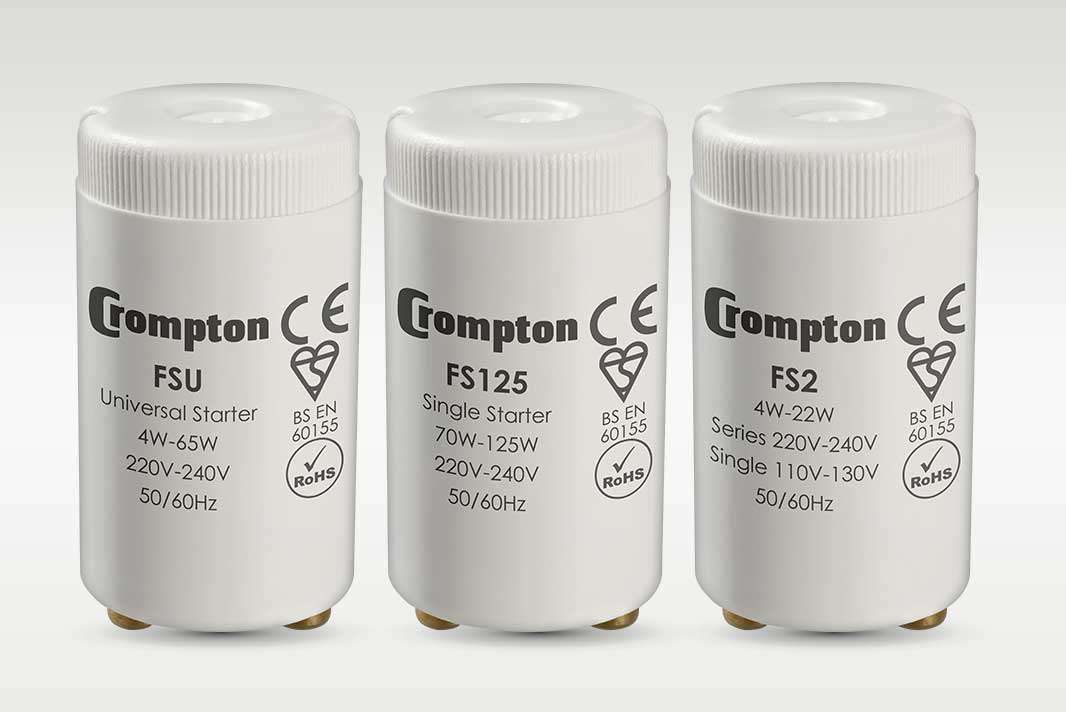
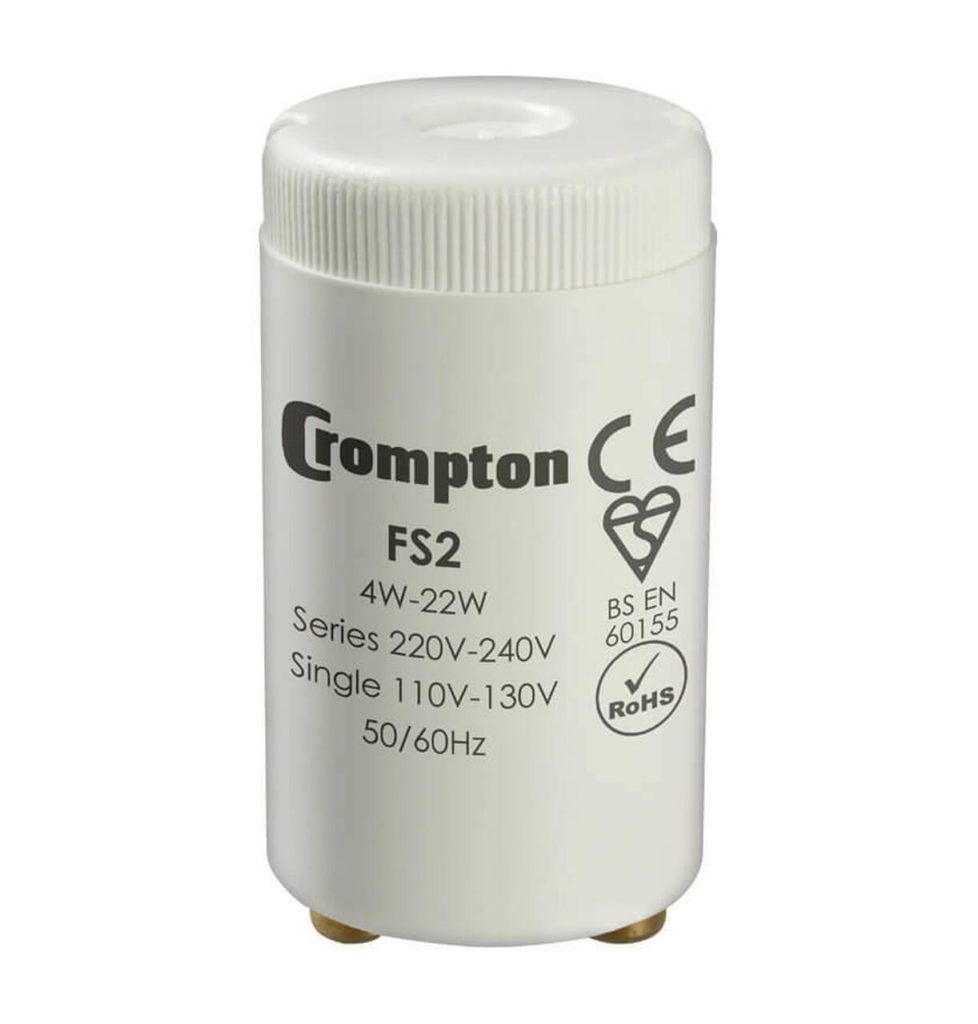
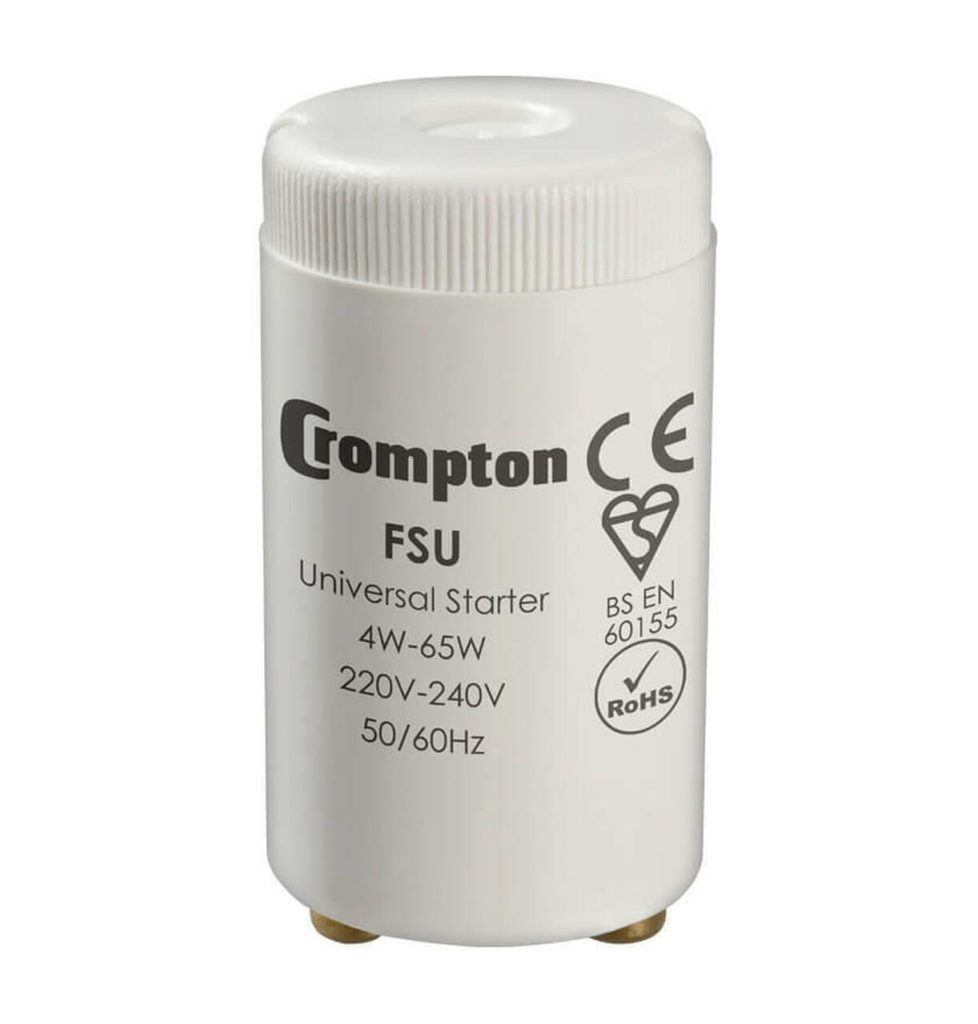
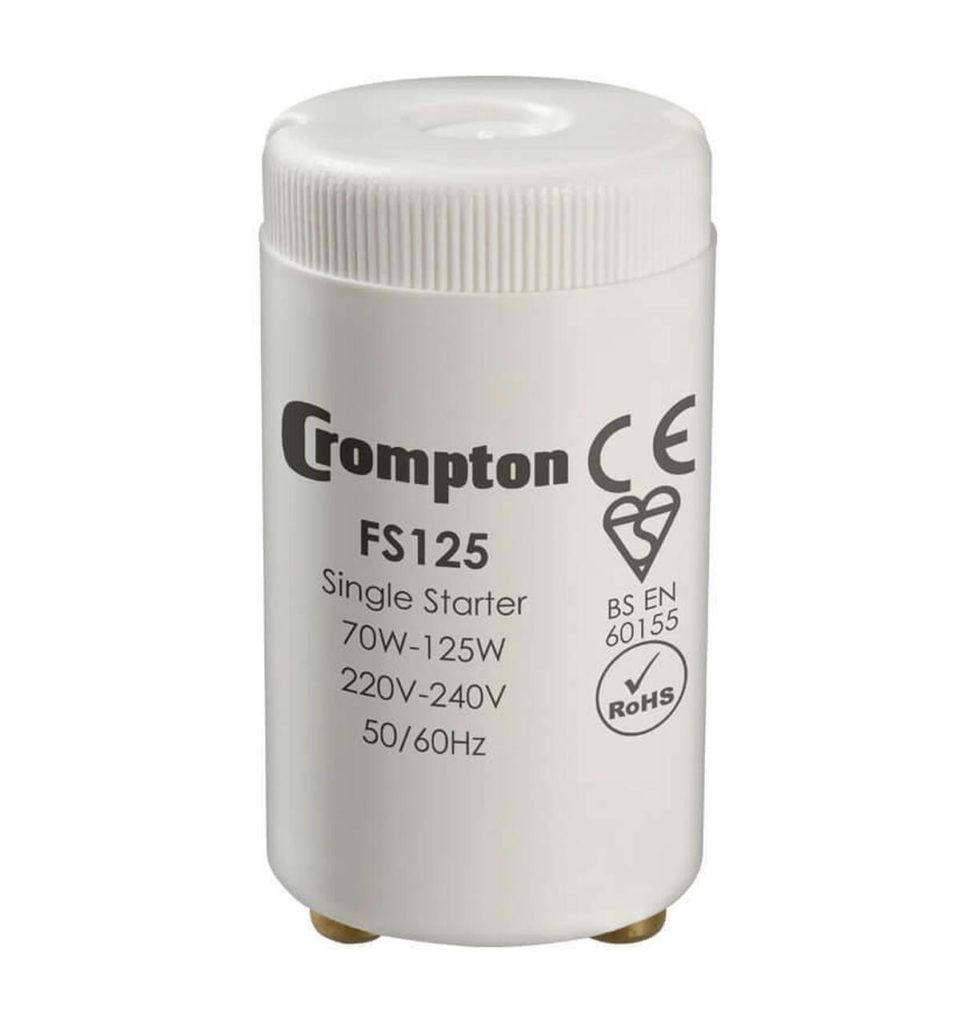

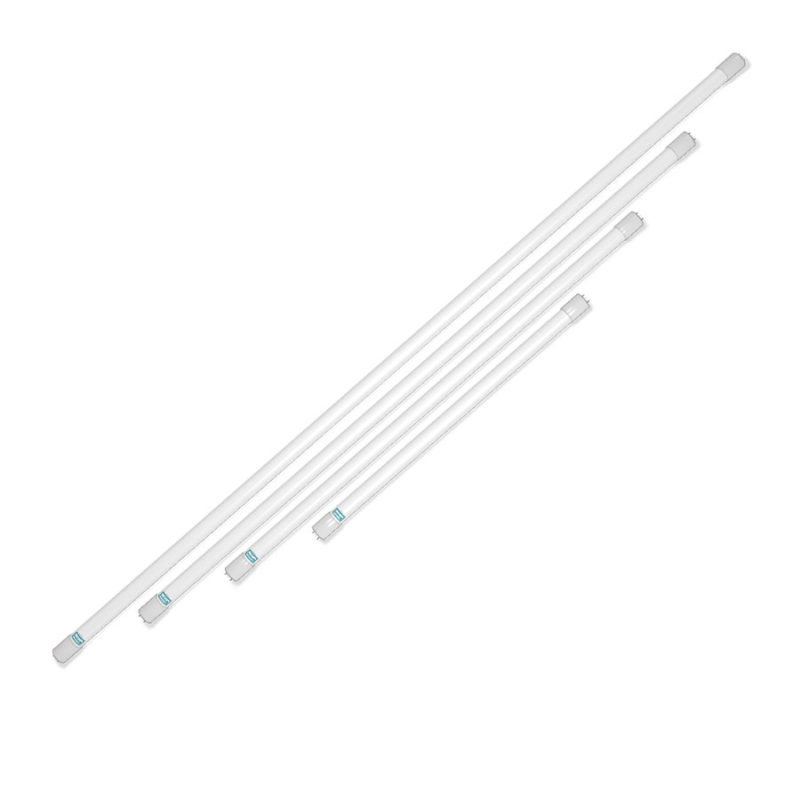
Have just bought Compton Circular T9 4w-65w 220 -240 lamp….when fitted and switched on the starter did not light lamp. Can you please advise which Starter is recommended.
most are T8/ T12 compatible.
my lamps were installed 2009/10
Sorry, confused by your question. You bought a Crompton T9 lamp and want a starter for it? What is the wattage of the lamp? (4-65W is the wattage of our universal starter, which, coincidentally will probably be sufficient for your needs).
I have an old bug zapper. The bulb that was in it was a U-shaped bulb roughly 16 inches long. I bought a replacement bulb that is 50 watts. The starter on it is FS-4 with a condenser 30-36w 40-48w. My light won’t come on. Starter bad? And do I need a starter rated for 50watts?
Wether the starter is bad or not, I don’t think it is rated high enough for a 50W tube. Replace the starter with a Crompton Lamps Fluorescent Starter FSU 4W – 65W
I have an aquarium light that uses a Fs-4 fuse. Went to the hardware store and they said an fs-4b is the same. I have looked it up and now am uncertain. The bulb it a t-8. Please advise me.
Yeah you should be fine. All you need to check is the that the wattage of the T8 tube in the range of the FS-4b.
Can I use FS-2 to replace my FS-2B starter?
Should I remove the Starter if I’m planning on installing an LED bulb? Or is the Starter required for power?
If you upgrade to LED T8 Tubes, they come with a special LED Starter to swap out.
Can I replace an FS-U starter with an FS-5? The FS-U is difficult to obtain. It is for an 8W 12″ fluorescent light.
Not sure about the FS-5, but we have some FSU on order and they should be stock soon.
I have a FS-1P 10-20w starter w/condenser for approx.12″ circular fluorescent light. Seems hard to find this exact type., What can I substitute?
Our universal 4W-65W starter will probably do the trick.
My sister had me buy some Florence lights and they didn’t work
can i leave it out
No, your light will not work.
Can I replace an old FS-5x 4,6,8 WATT starter with a FS-5 4,6,8 WATT?
what will happen if i use a a st151 22w starter instead of a 155/800 starter
I have a bad FS-2C, How would I determine if need the 2C or if I could replace it with an FS-2 ?
The C stands for Condenser – this type of starter has an extra capacitor in it’s circuitry to make a smoother electrical output. You should be able to swap out with a FS-2 with no issues.
I have recently replaced a starter. Can I recycle the old one? I was wondering if I could take it to somewhere that takes old electricals for recycling (eg Currys).
Hi Therese, although we offer our own WEEE (Waste Electrical) recycling facility, for something as small as a starter you may want to look up somehwere local to you. You can find Local Authority owned facilities or you may find your local B&Q offers a free WEEE disposal facility.
Replacing a T9 4 prong bulb. The ends dimly lit orange and nothing in the middle. Is this a bad ballast? Bad bulb? Does the entire light fixture need to be replaced?
Could be both, bad tube or bad ballast. If you bought the tube from us, you could try purchasing a new tube, and if it works fine, then let us know and we will refund the full order for the first tube.
If I have an older fluorescent light fixture that uses a starter, then I can’t switch the tubes to LED tubes? I would have to replace the entire fixture or stick with the older type tubes?
Hi Reb, our LED T8 tubes come with a special LED starter that you swap out when you install the tube meaning they are a simple replacement for flourescent tubes.
What do I do if my LED is starting to have a slight delay in turning on. Does that mean new bulbs? The bulbs are 3ft tubes.
Hi Jody, with this being a tube, we suspect that the ballast in your fitting may be the cause. You could try a new tube and see if the same thing happens?
I can’t find the start on a duo lamp system – can you let me know where to find it?
Hi Philly, chances are that your fitting uses a high-frequency electronic ballast that supplies it’s own boost to light up the lamps. There is no requirement for a starter in these type of fittings.
Helpful thanks
What is the difference between an fs-5 starter and an sfv-5 starter? Are they interchangeable?
Sorry Brenda, I can’t find any information on this starter. Perhaps you could type out all the text you see on the starter and we may be able to identify it.
I have a Blackflag bug zapper 5500 40w for about 5 yrs, it has worked perfectly up until recently.
It’s got the 4pin receptacle and on the backside of it with the wires it has a 1250V HEL 472J capacitor soldered to this receptacle . It’s also got the black U Shaped Florescent Tube.
I’ve been reading a lot and I did see on a few sites that some equipment has a start capacitor instead of the micro starter, maybe newer technology? I say this because I cannot find a micro starter anywhere.
On the board there are some thumbnail sized encased in the metal housing like the larger starters I’ve seen the pictures of, but the ones on my board are much much smaller and smaller diameters also. Again thumb nail size and much smaller.
Thank you in advance
Great thread going here
As all UV lamps are fluorescent technology, they all require the same standard of technology to ignite the tube. As long as the unit is in working capacity, you should just replace the tube like-for-like, i.e. a 40W U shaped 4-pin tube.
My housing commission flat does not have a see-able starter fuse for my fluorescent light tube
You may have an electronic ballast in the fitting which doesn’t require a starter, but would not the housing commission be responsible for replacement of tubes?
Hello, Can you tell me the difference between an FS-4C 13-30-40W starter and an FS-4 13-30-40W (No “C” in the second one) and can I buy them from you? Also may I use a 40W starter with a 25W tube? Thanks, Nancy
So the ‘C’ stands for the old-term ‘condenser’, a more modern way of explaining this is that there is a capacitor in the starter. This capacitor makes the electric current in phase with the ballast in the fitting ensuring a smoother and slightly more efficient electrical supply to the tube. We do not sell FS-4 starters of either type, but a quick google search shows various websites that do. I would suggest you contact one of them to ask about wattage and whether you need to use a C or non-C.
Thank you so much.
I have 4pin energy lamp for bathroom what size starter do I need
Hi, I need to replace the starter on a bulb on an industrial embroidery machine. The starter on there at the moment is an NEC FG-4P 36.40. I’ve tried to find a replacement, but I’m guessing it’s a Japanese starter. Is there a UK equivalent? I’d be grateful for any help – I don’t want to blow aa fuse! Thanks.
Tough one, on the face of it, this looks like a simple 40W starter, but we cannot find any technical data-sheets to back that up, and we certainly wouldn’t want to recommend a wrong solution. We did, however, notice that there are various sellers on Amazon who can ship this starter from Japan to the UK, some in boxes of 25, so might be worth getting a bulk shipment in like that to keep you going for a few years?
I have a bathroom mirror with integral 18W F18/T8 600mm fluorescent tubes. I can’t see a starter anywhere. Can I replace these tubes with LED equivalents?
You can, but you would have to re-wire the fitting to bypass the fluorescent transformer inside the fitting. Then an LED tube like our 2ft Cool white T8 tube would be an excellent equivalent.
The starter needs replacing on my fluorescent tube and I am having problems trying to replace the starter. Whilst it is supposed to be a standard fit, I have purchased 2 of the correct wattage and whilst it looks the same, does not fit snuggly the way the old one does. The one I have is 4-65W made by Kingfisher. Can you help?
Starters have a universal fitting meaning that any brand of starter should fit. I suspect something is wrong with your fitting, maybe something has become corroded or bent out of shape?
The starter should rotate roughly a quarter-turn anticlockwise for removal, and the opposite direction for insertion of a replacement. Perhaps the starter socket has become distorted. If the new device is not making contact you can tease out the starter socket contacts with a screwdriver to bring them back in play (with the luminaire isolated or course, though.
Just replaced the 4’ fluorescent tubes in my father’s garage. Looks like new starters are also required. Any idea what starter should be used to replace PGSU 200/250V single 32-40W starters?
Our FSU Universal starter 4W – 65W should suffice
I have a Budweiser pool table light it has two fluorescent tubes 33″ long. I put two new F2T12CW33 tubes and two new FS25 starters. When I turned the light on, I got a quick burst of light at one end of the fluorescent tubes and then nothing. I can’t find information on what tubes or starters it should have in this light.
Hi Robert, Although we don’t sell them, going by the part numbers, you’re starters aren’t rated with a high enough wattage. The tubes are rated at 33W, but the starter’s are rated at 25W – so they probably aren’t providing enough power to start the tube. You could try swapping out to our 4W to 65W starters.
can a bad tube and aged starter completely blow the power out in a bathroom??
how do i test a starter to see whether or not it’s still good?
Possibly – there is quite a large surge of power going to the tube to ‘fire’ it up and this could have tripped your circuit. Starters are pretty cheap to buy and we always recommend swapping out the starter to a new one each time the tube is replaced.
A new replacement Sylvania FS11 70 w starter causes tube to flicker. Is there a more powerful starter available or is it time to replace the tube?
Is the starter kicking in again after the tube has been lit? If working perfectly, when the tube is lit, the starter remains open. So I suspect the tube is failing, or possibly the ballast in the fitting.
I’m replacing a T12 75W, 110v Dual bulb starter. What starter do I need?
Having searched around the internet we cannot find any suitable starter – are you sure you require a 75W 110V?
Need to replace an electronic starter for a 40W circular tube. Old part is YZ140EA but only same size replacement I can find is YZ138EAA (ie. rated for a 38W tube). Any idea if I’m likely to hit a problem fitting the 38W starter?
A 38W starter may not provide enough ooompf to ignite a 40W tube, but why couldn’t you use a FSU starter which are rated from 4W to 65W? Is it a high frequency fitting?
Hi – if I remove the tube but not the starter, does this still use electricity or none at all?
I have an old 12″ light in our bathroom with a bad starter. The starter is an FSV-12 for 32 w circline. Obviously it is not the correct one but it worked for decades. However, it is unique from any I’ve ever seen because it has a groove in the head of the pins. A regular FS2 will not fit in the socket. I don’t see any on-line. Is this an obsolete starter? Is there a small ballast replacement for this like there is for the 4 ‘ ceiling lights?
Thanks
Sorry to hear you are having difficulty in finding these starters – they are not familiar to us either. Does the FSV-12 starters have a brand name for a company you could contact and see if they have any UK distributors?
A 32W circline tube needs a FSU starter. That will run it absolutely fine. FSV12 was an old starter denomination that was declared unnecessary as anything from a 3ft 30W (which a 32w circline is, in principle) up to a 5 ft 80W will comply electrically. Fit a new lamp and an FSU, if you haven’t discovered this already 🙂
I have a 4 pin T5 40w 6400k circular flourescent ring but i can’t find what starter i need, the one that is in has disintergrated so i don’tk now no. can anyone help please.
Starters are rated for the wattage of lamp they can be used with, so with a 40W tube, you could try our 4W to 65W starter
Do I need a starter for a new 28W CFL CC GR10q – 4pin, col. 835 – 3500K White? It’s taking about 5 mins to come on which isn’t great for a bathroom light. The lighting shop didn’t mention replacing a starter. I don’t even know what one if any to get. Thanks
No, they don’t use starters – BUT, the light fitting will have control gear inside to drive the lamp – this is probably on it’s way out. Probably time to replace the fitting, I’m afraid.
Some fittings for 28w 4-pin 2D lamps do use starters. You will need a FSU if that’s the case in your luminaire. Don’t throw out the fitting unless you’ve checked this. Two-pin versions are the only type that absolutely do not require a separate starter as one is incorporated in the lamp itself.
You say “current creates two electrodes inside the fluorescent starter to heat and glow”. Would it be better to say “current causes two electrodes inside the fluorescent starter to heat and glow”?
This article actually does NOT explain how starters work. The starters are actually gas tubes. The gas lights up and the current causes it to heat up enough for the bi-metal strip to bend and make contact between the electrodes. When that happens the current is directed through the filaments of the fluorescent lamp in series. THEN, they cool off because the contacts are connected. When they cool off and disconnect the ballast current spikes a voltage across the lamp which now has hot filaments and the tube lights. The voltage across the now lighted lamp is too low to relight the starter.
Have question .. why with new bulb & starter does flourescent still flicker. I have to remove starter to get bulb on & is fine.
Wrong starter. Specifics would help. In another comment, I have left a table of starters and suitable lamps. What is happening is the operating voltage of the tube is above the critical enagaging voltage of the starter causing it to operate, if the tube runs fine when it is removed.
Hi. The starter on my old stove’s fluorescent light blew and shattered. I’m using t8, 18 watt double ended fluorescent tube. Hard to still find, but I stocked up. If it makes any difference, the ballast is magnetic. So would the universal FSU 4 watt to 65 watt single tube starter work for me? And is it normal for the old starter to shatter and flash when it needs replacement?
Hi Nancy, firstly, yes, the FSU 4W-65W starter is correct for you. I’ve certainly not come across an old starter shattering before – I can only assume the material has degraded over time due to the heat of the stove.
What is the difference between a FS-2 and FS-5 Starter. They both seem to work fine in an 18″ bar light? Are they interchangable?
Some starter state ‘with condenser’ and others don’t. My existing starter is an FS-U 65-70w with condenser for a 6 foot tube. What is the difference if any?
Hi Les, it’s just terminology, condenser vs capacitor – they are all the same thing. You are able to replace with Crompton Lamps Fluorescent Starter FSU 4W – 65W or Crompton Lamps Fluorescent Starter 70W – 125W (depending on the wattage of your tubes).
i have got 58w t26 light what starter would i need
You need a universal 4W to 65W starter
Can you use a FS-2 starter 14.15.20w to replace a FS-U 14.15.20w starter ? Thanks
Yes
Hi there, before I read this message, I didn’t know what it was all about, but the Fluorescent in my kitchen failed to switch on, then all what you said made sense to me, I’ve now changed the Starter which wasn’t working properly & I saw that the Fluorescent started to work properly.
Thanks for your help.
What was the last year that they made fluorescent fixtures with starters??
Useful article, thanks. I’ve noticed that FS125 starters have been installed on a number of fittings that have 36w, 58w and 70w tubes. I guess at some point someone thought its easier just to buy one box to cover all fittings. Is this an issue for the lower wattage tubes or should FSU be swapped in?
FS125’s have a rating of 70W – 125W, so yes, we would advise swapping to FSU starters on those 36W and 58W fittings.
They’ll operate, but suboptimally. Risk of cold-starting that might wear out the lamp prematurely. FSU for the 36w and 58w, and FS125 for the 70w should be fine.
I tried to insert starter unit it went straight through into the strip light what can l do
For safety reasons it would be best to replace the fitting. Something may have broken inside the fitting.
The starter unit went strait through the hole what can l do
Thank you for all the good info on your website! I was wondering if an FS-2 starter can substitute for an FS-2C. I cannot find the 2c starters and any references on the web seem to be from people who bought FS-2 starters and say that it is ok based on that it seems to work
This is for a lamp that is 22 years old. It is in a kitchen pantry and is usually only on for short periods of time so I really don’t need to buy an LED to save electricity. There is a Phillips F20T12/0 bulb in the lamp.
So is an FS-2 ok or should I replace the whole lamp. I don’t want there to be any problems. Thanks!
Just done a search for FS2C and can’t find anything decisive on that code. Certainly the wattage of a FS-2 is in tolerance with the F20T12/0 tube you have fitted – so it should work.